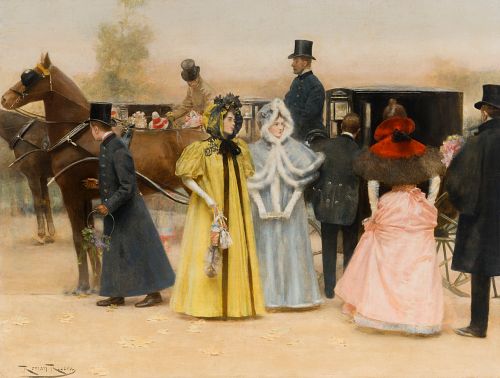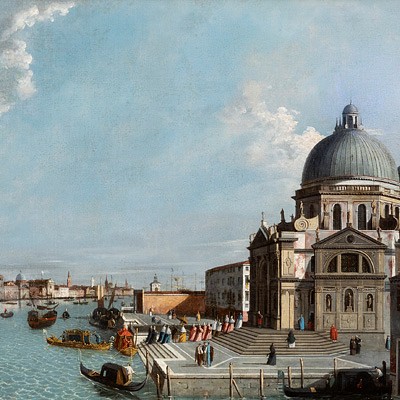ROMÁN RIBERA CIRERA (Barcelona, 1848 - 1935). "Carriage and figures". Oil on canvas. Reengineered. Signed in the lower left corner. Measurements: 67 x
Lot 38
About Seller
Setdart Auction House
Carrer Aragó 346
Barcelona
Spain
Setdart Subastas was born in 2004 and is currently the first online art auction in Spain with solidity, prestige and reliability guaranteed by our more than 60,000 users. Setdart has a young, dynamic and enterprising team ready to successfully manage the purchase and sale of art works through custom...Read more
Estimate:
EUR€20,000 - EUR€25,000
$21,739.13 - $27,173.91
Absentee vs Live bid
Two ways to bid:
- Leave a max absentee bid and the platform will bid on your behalf up to your maximum bid during the live auction.
- Bid live during the auction and your bids will be submitted real-time to the auctioneer.
Bid Increments
| Price | Bid Increment |
|---|---|
| EUR€0 | EUR€10 |
| EUR€200 | EUR€25 |
| EUR€500 | EUR€50 |
| EUR€1,000 | EUR€100 |
| EUR€3,000 | EUR€200 |
| EUR€5,000 | EUR€500 |
| EUR€10,000 | EUR€1,000 |
| EUR€20,000 | EUR€2,000 |
| EUR€50,000 | EUR€5,000 |
About Auction
By Setdart Auction House
May 18, 2021
Set Reminder
2021-05-18 09:30:00
2021-05-18 09:30:00
America/New_York
Bidsquare
Bidsquare : Classics XIX and XX
https://www.bidsquare.com/auctions/setdart-auction-house/classics-xix-and-xx-6961
The next 18th May there will be a 19th and 20th Century Classics Auction at Setdart.com There will be a select repertoire of important artists such as Carlos Cruz Diez, Luis Feito, Joan Miró, Fernando Botero, Josep Llimona, Salvador Dalí among others. Setdart Auction House sofia@setdart.com
The next 18th May there will be a 19th and 20th Century Classics Auction at Setdart.com There will be a select repertoire of important artists such as Carlos Cruz Diez, Luis Feito, Joan Miró, Fernando Botero, Josep Llimona, Salvador Dalí among others. Setdart Auction House sofia@setdart.com
- Lot Description
ROMÁN RIBERA CIRERA (Barcelona, 1848 - 1935). "Carriage and figures". Oil on canvas. Reengineered. Signed in the lower left corner. Measurements: 67 x 89 cm; 102 x 120 cm (frame). In addition to making historicist paintings with tavern scenes, chivalrous scenes or groups of musicians reminiscent of the Dutch and Spanish work of the seventeenth century for its atmosphere and excellent execution, Roman Ribera also portrayed the elegant and lavish life of the bourgeoisie of the end of the century. So it is in this work, where the artist represents the economic power of the wealthy classes, refining the details and without shying away from realism. For this he uses a chromatic range of temperate and moderate tones, which he punctuates and contrasts, however, with the colors -yellow, blue and pink- of the clothes of the female figures in the foreground of the scene. In this work Román Ribera achieves a warm and distinguished environment in which his protagonists are housed, the result of the precision in the drawing, the care in the application of color, and the filtered light with which he manages to envelop the environments. Catalan painter, Román Ribera studied drawing at the School of La Lonja in Barcelona, and painting at the academy of Pere Borrell. He furthered his studies in Rome, between 1873 and 1976, and traveled and exhibited in London. In the Italian capital he attended the Chigi Academy and dedicated himself to painting, but avoiding the contagion of the academicist mannerism of the Roman school. In 1877 he went to Paris, under the guidance of the art dealer Adolphe Goupil, who had acquired the rights to reproduce all his work. There he continued his training, this time directly studying scenes of Parisian street life. A year later, he took part in the Universal Exhibition in Paris, where he obtained a decisive success thanks to the three works he presented, of a remarkable verism with literary roots. However, he did not feel at ease with this type of themes, and soon began to focus on depicting the elegant life of the time, in works such as "Exit from the ball", which alternates with genre scenes in the Spanish Baroque tradition as "A flamenco drinker". In 1881 he took part in the National Exhibition of Madrid precisely with the aforementioned work of baroque setting, and in 1883 he was awarded the Encomienda de Isabel la Católica. After twelve years in Paris he returned to Barcelona, where he had already exhibited at the Centro de Acuarelistas (1885) and at the recently inaugurated Sala Parés. He then showed his work at the Artistic and Literary Association and at the Parés and Rovira halls, as well as at the Universal Exhibition of 1888 and the Fine Arts Exhibition of 1894, obtaining great critical and public success, soon gaining the favor of the wealthy Catalan bourgeoisie. In 1893 he presented two paintings to the Exhibition organized by the Ateneo de Barcelona: "Inocencia" and "Incógnitca". Individually Cirera regularly showed his work in the Rovira room and, as a group, he was a member of the Artistic and Literary Society of Catalonia. He was part of several official juries, and also of the Board of Museums of Barcelona, in 1901. In 1915 he was named Member of Merit of the Artistic Circle of Barcelona. On his return to Spain, Ribera continued to depict the life of the upper classes, the luxury of their homes, the richness of their party dresses, etc., becoming a faithful portraitist of the Catalan high bourgeoisie of the Restoration, as he had already been of the French bourgeoisie of the Third Republic. He worked mainly in Barcelona, but also traveled to Madrid and held exhibitions of his work there. His work is currently conserved in the MACBA in Barcelona, the Museu d'Art de Girona, the Museu de Montserrat, the Biblioteca Víctor Balaguer and in various important private collections.
- Shipping Info
-
In-House Shipping
-
- Buyer's Premium



 EUR
EUR CAD
CAD AUD
AUD GBP
GBP MXN
MXN HKD
HKD CNY
CNY MYR
MYR SEK
SEK SGD
SGD CHF
CHF THB
THB
















